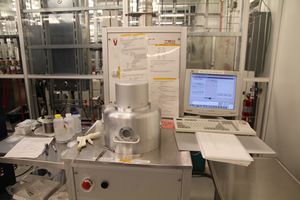PECVD 1 (PlasmaTherm 790): Difference between revisions
link to recipes and data |
|||
| Line 13: | Line 13: | ||
__TOC__ |
__TOC__ |
||
= About = |
== About == |
||
This is a Plasma-Therm model 790 plasma enhanced chemical vapor deposition system for depositing SiO<sub>2</sub>, Si<sub>3</sub>N<sub>4</sub>, or SiO<sub>x</sub>N<sub>y</sub> dielectric films. The system uses a capacitively-coupled 13.56 MHz source excitation to produce the plasma between two parallel aluminum plates. The gas is injected over the sample through a 6” diameter showerhead. The samples are placed on the system anode (to minimize ion damage) which is heated to 250-350°C. SiO<sub>2</sub> is produced from SiH<sub>4</sub>/He 2%/98% and N<sub>2</sub>O at 250°C. The typical deposition rate is 400 A/min. at 300 mT pressure. The typical BOE etch rate of this oxide is about 400 nm/min. Si<sub>3</sub>N<sub>4</sub> is produced from SiH<sub>4</sub>/He 2%/98% and NH<sub>3</sub> at 250°C or 350°C. The more dense films are produced at 350°C. The stress of the nitride can be altered by adjusting the N<sub>2</sub>:He ratio of the deposition. CF<sub>4</sub>/O<sub>2</sub> plasmas are used to clean the chamber between depositions. |
This is a Plasma-Therm model 790 plasma enhanced chemical vapor deposition system for depositing SiO<sub>2</sub>, Si<sub>3</sub>N<sub>4</sub>, or SiO<sub>x</sub>N<sub>y</sub> dielectric films. The system uses a capacitively-coupled 13.56 MHz source excitation to produce the plasma between two parallel aluminum plates. The gas is injected over the sample through a 6” diameter showerhead. The samples are placed on the system anode (to minimize ion damage) which is heated to 250-350°C. SiO<sub>2</sub> is produced from SiH<sub>4</sub>/He 2%/98% and N<sub>2</sub>O at 250°C. The typical deposition rate is 400 A/min. at 300 mT pressure. The typical BOE etch rate of this oxide is about 400 nm/min. Si<sub>3</sub>N<sub>4</sub> is produced from SiH<sub>4</sub>/He 2%/98% and NH<sub>3</sub> at 250°C or 350°C. The more dense films are produced at 350°C. The stress of the nitride can be altered by adjusting the N<sub>2</sub>:He ratio of the deposition. CF<sub>4</sub>/O<sub>2</sub> plasmas are used to clean the chamber between depositions. |
||
| Line 19: | Line 19: | ||
These films are typically used for capacitor dielectrics, chemical passivation layers, electrical insulators, reactive ion etching masks, and optical anti-reflective coatings. The system is fully programmable with windows-based software and has a wide array of pre-defined thicknesses. Custom programs for dielectric stacks or different process parameters can be written and saved. |
These films are typically used for capacitor dielectrics, chemical passivation layers, electrical insulators, reactive ion etching masks, and optical anti-reflective coatings. The system is fully programmable with windows-based software and has a wide array of pre-defined thicknesses. Custom programs for dielectric stacks or different process parameters can be written and saved. |
||
= Detailed Specifications = |
== Detailed Specifications == |
||
*Gases used: NH<sub>3</sub>, N<sub>2</sub>O, 2%SiH<sub>4</sub>/He, N<sub>2</sub>,CF<sub>4</sub> and O<sub>2</sub> |
*Gases used: NH<sub>3</sub>, N<sub>2</sub>O, 2%SiH<sub>4</sub>/He, N<sub>2</sub>,CF<sub>4</sub> and O<sub>2</sub> |
||
| Line 30: | Line 30: | ||
*Standard recipes for a variety of film thicknesses |
*Standard recipes for a variety of film thicknesses |
||
=Documentation= |
==Documentation== |
||
*[https://wiki.nanotech.ucsb.edu/w/images/d/d2/PECVD1_Operating_Instructions.pdf Operating Instructions] |
*[https://wiki.nanotech.ucsb.edu/w/images/d/d2/PECVD1_Operating_Instructions.pdf Operating Instructions] |
||
*[[PECVD1 Wafer Coating Process|Wafer Coating Process Traveler]] |
*[[PECVD1 Wafer Coating Process|Wafer Coating Process Traveler]] |
||
*For particle counting method, see the [https://wiki.nanotech.ucsb.edu/wiki/Wafer_scanning_process_traveler Surfscan Scanning Procedure] |
*For particle counting method, see the [https://wiki.nanotech.ucsb.edu/wiki/Wafer_scanning_process_traveler Surfscan Scanning Procedure] |
||
== Recipes & Process Information == |
|||
* Historical Characterization Data & Standard Recipes can be found at: [[PECVD Recipes#PECVD 1 .28PlasmaTherm 790.29|'''Recipes > Deposition > <u>PECVD1</u>''']] |
|||
Revision as of 17:41, 8 September 2020
| |||||||||||||||||||||
About
This is a Plasma-Therm model 790 plasma enhanced chemical vapor deposition system for depositing SiO2, Si3N4, or SiOxNy dielectric films. The system uses a capacitively-coupled 13.56 MHz source excitation to produce the plasma between two parallel aluminum plates. The gas is injected over the sample through a 6” diameter showerhead. The samples are placed on the system anode (to minimize ion damage) which is heated to 250-350°C. SiO2 is produced from SiH4/He 2%/98% and N2O at 250°C. The typical deposition rate is 400 A/min. at 300 mT pressure. The typical BOE etch rate of this oxide is about 400 nm/min. Si3N4 is produced from SiH4/He 2%/98% and NH3 at 250°C or 350°C. The more dense films are produced at 350°C. The stress of the nitride can be altered by adjusting the N2:He ratio of the deposition. CF4/O2 plasmas are used to clean the chamber between depositions.
These films are typically used for capacitor dielectrics, chemical passivation layers, electrical insulators, reactive ion etching masks, and optical anti-reflective coatings. The system is fully programmable with windows-based software and has a wide array of pre-defined thicknesses. Custom programs for dielectric stacks or different process parameters can be written and saved.
Detailed Specifications
- Gases used: NH3, N2O, 2%SiH4/He, N2,CF4 and O2
- ~ 10mT ultimate chamber pressure
- 13.56 Mhz excitation freq.
- Sample size: pieces to 6” wafers
- Automatic tuning network
- RF Power control
- Full computer operation
- Standard recipes for a variety of film thicknesses
Documentation
- Operating Instructions
- Wafer Coating Process Traveler
- For particle counting method, see the Surfscan Scanning Procedure
Recipes & Process Information
- Historical Characterization Data & Standard Recipes can be found at: Recipes > Deposition > PECVD1
